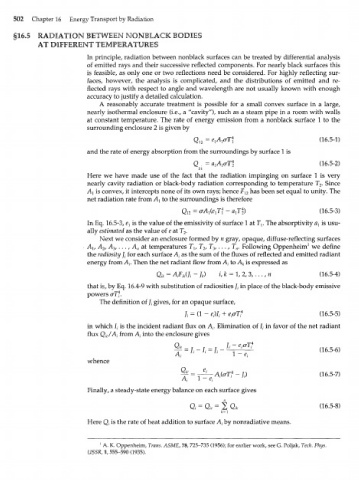Page 522 - Bird R.B. Transport phenomena
P. 522
502 Chapter 16 Energy Transport by Radiation
§16.5 RADIATION BETWEEN NONBLACK BODIES
AT DIFFERENT TEMPERATURES
In principle, radiation between nonblack surfaces can be treated by differential analysis
of emitted rays and their successive reflected components. For nearly black surfaces this
is feasible, as only one or two reflections need be considered. For highly reflecting sur-
faces, however, the analysis is complicated, and the distributions of emitted and re-
flected rays with respect to angle and wavelength are not usually known with enough
accuracy to justify a detailed calculation.
A reasonably accurate treatment is possible for a small convex surface in a large,
nearly isothermal enclosure (i.e., a "cavity"), such as a steam pipe in a room with walls
at constant temperature. The rate of energy emission from a nonblack surface 1 to the
surrounding enclosure 2 is given by
Q l 2 = e A &T\ (16.5-1)
x
{
and the rate of energy absorption from the surroundings by surface 1 is
Q . = a A oT\ (16.5-2)
x
x
21
Here we have made use of the fact that the radiation impinging on surface 1 is very
nearly cavity radiation or black-body radiation corresponding to temperature T . Since
2
A is convex, it intercepts none of its own rays; hence F has been set equal to unity. The
x u
net radiation rate from A x to the surroundings is therefore
Q = aA (e T — a{T^) (16.5-3)
1 2 x x x
In Eq. 16.5-3, e is the value of the emissivity of surface 1 at TV The absorptivity a is usu-
x
x
ally estimated as the value of e at T .
2
Next we consider an enclosure formed by n gray, opaque, diffuse-reflecting surfaces
A], A , A ,..., Д, at temperatures TV T , T ,..., T . Following Oppenheim 1 we define
2 3 2 3 n
the radiosity ] i for each surface Д as the sum of the fluxes of reflected and emitted radiant
energy from Д. Then the net radiant flow from Д to A is expressed as
k
Q ik = A,F (J, - /,) i,* =1,2,3 n (16.5-4)
ik
/
that is, by Eq. 16.4-9 with substitution of radiosities in place of the black-body emissive
;
powers <rTj.
The definition of /, gives, for an opaque surface,
/, = (1 - eft + epT? (16.5-5)
in which Ij is the incident radiant flux on Д. Elimination of /, in favor of the net radiant
flux Qie/Aj from Д into the enclosure gives
% = /i ~ h = Ji ~ Ji 7 !|° ГТ/ (16.5-6)
/ij i e t
whence
% = ^t~ AfaT? - Jj) (16.5-7)
/ij i e x
Finally, a steady-state energy balance on each surface gives
Q/ = Qie = I Qik (16.5-8)
Here Q, is the rate of heat addition to surface Д by nonradiative means.
1
A. K. Oppenheim, Trans. ASME, 78, 725-735 (1956); for earlier work, see G. Poljak, Tech. Phys.
USSR, 1, 555-590 (1935).

